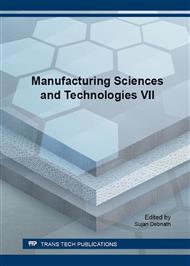[1]
B. S. Ndazi, et al., Chemical and physical modifications of rice husks for use as composite panels. Composites Part A: Applied Science and Manufacturing, 2007. 38: pp.925-935.
DOI: 10.1016/j.compositesa.2006.07.004
Google Scholar
[2]
O. Faruk, , et al., Biocomposites reinforced with natural fibers: 2000–2010. Progress in Polymer Science, 2012. 37(11): pp.1552-1596.
DOI: 10.1016/j.progpolymsci.2012.04.003
Google Scholar
[3]
M. W. Dewan, et al., Thermomechanical properties of alkali treated jute-polyester/nanoclay biocomposites fabricated by VARTM process. Journal of Applied Polymer Science, 2013. 128(6): pp.4110-4123.
DOI: 10.1002/app.38641
Google Scholar
[4]
A. Nourbakhsh, F.F. Baghlani, and A. Ashori, Nano-SiO2 filled rice husk/polypropylene composites: Physico-mechanical properties. Industrial Crops and Products, 2011. 33(1): pp.183-187.
DOI: 10.1016/j.indcrop.2010.10.010
Google Scholar
[5]
J. S. Lim, et al., A review on utilisation of biomass from rice industry as a source of renewable energy. Renewable and Sustainable Energy Reviews, 2012. 16(5): pp.3084-3094.
DOI: 10.1016/j.rser.2012.02.051
Google Scholar
[6]
S. L. Rosa, S. B. Nachtigall, and C. Ferreira, Thermal and dynamic-mechanical characterization of rice-husk filled polypropylene composites. Macromolecular Research, 2009. 17(1): pp.8-13.
DOI: 10.1007/bf03218594
Google Scholar
[7]
S. D. Genieva, , S. C. Turmanova, and L.T. Vlaev, Utilization of Rice Husks and the Products of Its Thermal Degradation as Fillers in Polymer Composites, in Cellulose Fibers: Bio- and Nano-Polymer Composites, S. Kalia, B.S. Kaith, and I. Kaur, Editors. 2011, Springer Berlin Heidelberg. pp.345-375.
DOI: 10.1007/978-3-642-17370-7_13
Google Scholar
[8]
K. Majeed, et al., Potential materials for food packaging from nanoclay/natural fibres filled hybrid composites. Materials & Design, 2013. 46(0): pp.391-410.
DOI: 10.1016/j.matdes.2012.10.044
Google Scholar
[9]
M. Khalid, , et al., Comparative study of polypropylene composites reinforced with oil palm empty fruit bunch fiber and oil palm derived cellulose. Materials & Design, 2008. 29(1): pp.173-178.
DOI: 10.1016/j.matdes.2006.11.002
Google Scholar
[10]
O. Nabinejad, et al, Mechanical and thermal characterization of polyester composite containing treated wood flour from Palm oil biomass, Polymer Composites, In press (DOI: 10. 1002/pc. 24052) (2016).
DOI: 10.1002/pc.24052
Google Scholar
[11]
I. A. T. Razera, and E. Fr Mohanty ollini, Composites based on jute fibers and phenolic matrices: Properties of fibers and composites. Journal of Applied Polymer Science, 2004. 91(2): pp.1077-1085.
DOI: 10.1002/app.13224
Google Scholar
[12]
H. Alamri, and I.M. Low, Effect of water absorption on the mechanical properties of nanoclay filled recycled cellulose fibre reinforced epoxy hybrid nanocomposites. Composites Part A: Applied Science and Manufacturing, 2013. 44(0): pp.23-31.
DOI: 10.1016/j.compositesa.2012.08.026
Google Scholar
[13]
T. H. Hsieh, et al., The toughness of epoxy polymers and fibre composites modified with rubber microparticles and silica nanoparticles. Journal of Materials Science, 2010. 45(5): pp.1193-1210.
DOI: 10.1007/s10853-009-4064-9
Google Scholar
[14]
S. Takahashi, et al., Gas barrier properties of butyl rubber/vermiculite nanocomposite coatings. Polymer, 2006. 47(9): pp.3083-3093.
DOI: 10.1016/j.polymer.2006.02.077
Google Scholar
[15]
B. Kord, Effect of Nanoparticles Loading on Properties of Polymeric Composite Based on Hemp Fiber/Polypropylene. Journal of Thermoplastic Composite Materials, 2012. 25(7): pp.793-806.
DOI: 10.1177/0892705711412815
Google Scholar
[16]
A. Chavooshi, et al., MDF dust/PP composites reinforced with nanoclay: Morphology, long-term physical properties and withdrawal strength of fasteners in dry and saturated conditions. Construction and Building Materials, 2014. 52(0): pp.324-330.
DOI: 10.1016/j.conbuildmat.2013.11.045
Google Scholar
[17]
A. R. Martin, et al., Studies on the thermal properties of sisal fiber and its constituents. Thermochimica Acta, 2010. 506(1-2): pp.14-19.
DOI: 10.1016/j.tca.2010.04.008
Google Scholar
[18]
O. Nabinejad, et al., Effect of oil palm shell powder on the mechanical performance and thermal stability of polyester composites. Materials & Design, 2015. 65: pp.823-830.
DOI: 10.1016/j.matdes.2014.09.080
Google Scholar
[19]
O. Nabinejad, et al., Determination of filler content for natural filler polymer composite by thermogravimetric analysis. Journal of Thermal Analysis and Calorimetry, 2015: pp.1-7.
DOI: 10.1007/s10973-015-4681-2
Google Scholar
[20]
P. M. Stefani, , et al., Thermogravimetric analysis of composites obtained from sintering of rice husk-scrap tire mixtures. Journal of Thermal Analysis and Calorimetry, 2005. 81(2): pp.315-320.
DOI: 10.1007/s10973-005-0785-4
Google Scholar
[21]
S. Mishra, et al., Studies on mechanical performance of biofibre/glass reinforced polyester hybrid composites. Composites Science and Technology, 2003. 63(10): pp.1377-1385.
DOI: 10.1016/s0266-3538(03)00084-8
Google Scholar
[22]
H. D. Rozman, et al., Tensile properties of kenaf/unsaturated polyester composites filled with a montmorillonite filler. Journal of Applied Polymer Science, 2011. 119(5): pp.2549-2553.
DOI: 10.1002/app.32096
Google Scholar
[23]
B. Kord, Nanofiller reinforcement effects on the thermal, dynamic mechanical, and morphological behavior of hdpe/rice husk flour composites. BioResources, 2011. 6(2): pp.1351-1358.
DOI: 10.15376/biores.6.2.1351-1358
Google Scholar
[24]
Y. Karaduman, and L. Onal, Water absorption behavior of carpet waste jute-reinforced polymer composites. Journal of Composite Materials, 2010 45(15): pp.1559-1571.
DOI: 10.1177/0021998310385021
Google Scholar
[25]
A. D. Drozdov, et al., Model for anomalous moisture diffusion through a polymer–clay nanocomposite. Journal of Polymer Science Part B: Polymer Physics, 2003. 41(5): pp.476-492.
DOI: 10.1002/polb.10393
Google Scholar


